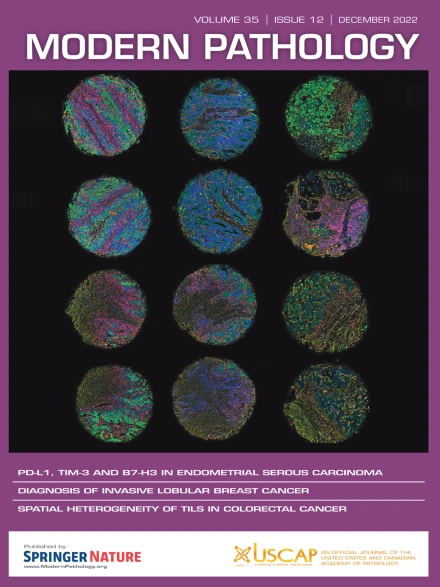Myeloid Neoplasms With Oligomonocytosis Exhibit Heterogenous Pathologic and Genetic Features
IF 5.5
1区 医学
Q1 PATHOLOGY
引用次数: 0
Abstract
The criteria used to classify patients with myeloid neoplasms and monocytosis have changed in the fifth edition of the World Health Organization classification (WHO5) and the International Consensus Classification (ICC). Although both classifications have reduced the absolute monocyte count threshold for chronic myelomonocytic leukemia (CMML) to 0.5 × 109/L, the ICC has also introduced new morphologic criteria for CMML. We studied the effect of these changes on a large cohort of myeloid neoplasms with white blood cell count < 13 × 109/L and blasts <20% that were previously classified using the fourth revised edition of the WHO classification of hematologic malignancies (WHO4r). The lower monocyte threshold might reclassify approximately 20% of WHO4r-defined myelodysplastic syndrome as myelodysplastic-type CMML (MD-CMML) in the new classifications. This change led to an 84% increase in MD-CMML by WHO5 criteria. The number of MD-CMML cases in the cohort decreases from 107 by WHO5 criteria to 40 by ICC criteria because of the morphologic criteria. New ICC criteria remove 55% of WHO4r-defined MD-CMML patients from the category, and these and other patients (13% of our cohort) are not classifiable by ICC criteria. ICC-defined CMML enriches for CMML-like genetic signatures, but we find that genetic classification and genetically informed risk models predict outcome better than monocyte counts or morphologic features.
髓系肿瘤伴少单细胞增多症表现出异质的病理和遗传特征。
髓系肿瘤和单核细胞增多症患者的分类标准在世界卫生组织第5版分类(WHO5)和国际共识分类(ICC)中发生了变化。虽然两种分类都将慢性髓细胞白血病(CMML)的绝对单核细胞计数阈值降低到0.5×109/L,但ICC也引入了CMML的新形态学标准。我们研究了这些变化对大量白细胞计数为9/L和原细胞的髓系肿瘤的影响
本文章由计算机程序翻译,如有差异,请以英文原文为准。
求助全文
约1分钟内获得全文
求助全文
来源期刊

Modern Pathology
医学-病理学
CiteScore
14.30
自引率
2.70%
发文量
174
审稿时长
18 days
期刊介绍:
Modern Pathology, an international journal under the ownership of The United States & Canadian Academy of Pathology (USCAP), serves as an authoritative platform for publishing top-tier clinical and translational research studies in pathology.
Original manuscripts are the primary focus of Modern Pathology, complemented by impactful editorials, reviews, and practice guidelines covering all facets of precision diagnostics in human pathology. The journal's scope includes advancements in molecular diagnostics and genomic classifications of diseases, breakthroughs in immune-oncology, computational science, applied bioinformatics, and digital pathology.
 求助内容:
求助内容: 应助结果提醒方式:
应助结果提醒方式:


